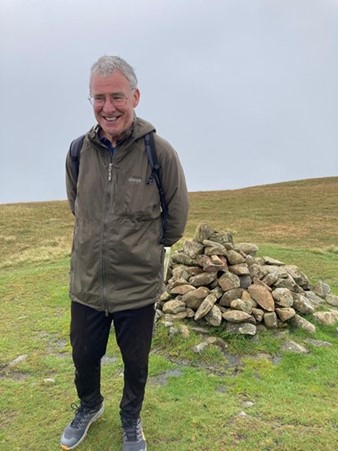
John Page was born in the West Riding, a proud Yorkshireman and was taught to play cricket left-handed “’cos it flummoxes t’ bowler, and buggers up t’ field.” He went to university in London and Leeds, and enjoyed (most of the time) attempting to teach young people that there’s a big wide world beyond the Colne and Worth Valleys. He also taught future captains of industry and government at the United World College of SE Asia in Singapore for four years. Except Antarctica, John has travelled and climbed extensively on all the world’s continents, with friends and with Hil, his wife of 44 years. Still very active in his seventies, retirement from paid employment was the best career move that he ever made.
Turbine 31: White Hill SD 97863 33041 ///prompt.adverbs.quirky
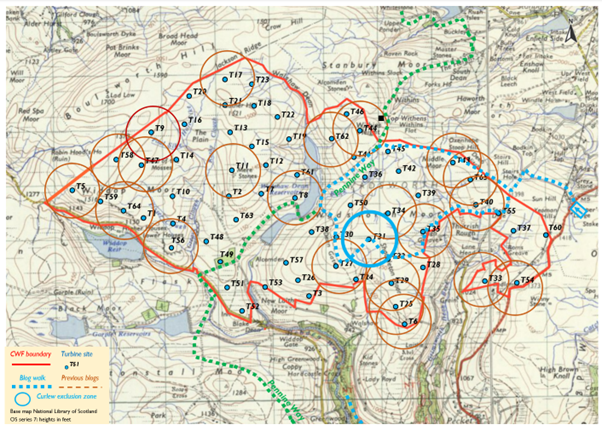
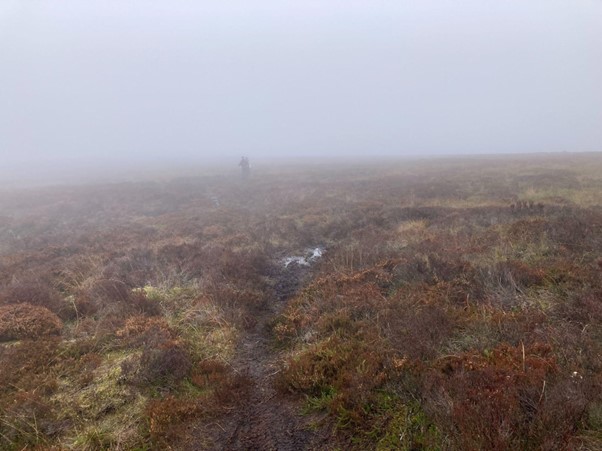
15 October 2024
I almost lost my “assistants” today; a couple of friends, once fair weather walkers, who agreed to join me on a walk into Bannister Country … on the proviso that it was mainly on good tracks. “Mainly” is a great word … wonderfully ambiguous. It is like the developer’s “Up to”. I only had to promise them a drink at the end in the Waggon and Horses pub just below the Cock Hill Elephant.
By the time that I met my friends in the big layby bus just above the pub I’d already met Nick MacKinnon in the flesh for the first time for our prearranged clandestine handover of aluminium stealth technology. I even got a quick demonstration of how to use it, much to the amusement of the passengers on the passing 500 bus from Keighley. I’d then left Nick to continue his journey to meet with his own band of happy wanderers in the Hebden Bridge Coop car park, and I’d gone for my 9.50 Covid/flu jab in Oxenhope, another opportunity to chat with other retirees about the proposed wind farm as we queued up in the small pharmacy.
The route that I’d planned would have been an enjoyable romp if the weather had been better. But it wasn’t. Fortunately though Mary is a retired R.E. teacher so, with her God with us, it didn’t really rain all day, although visibility was never more than a few yards. And John used to teach P.E. (a long time ago!). I supposed he enjoyed walking for its own sake, getting his endorphins whizzing around in his system.
And me. I just enjoy being out, whatever the weather. It’s better than watching Countdown. And although the Channel 4 News still showed a very unhappy world when I got home, I was surprised, because we’d certainly attempted to put the world to rights as we walked.
Anyway, an easy start along the wide horizontal ‘catch path’ (marked ‘conduit’ on the map) to Stairs Lane and on to Little Stairs Brink. It’s only now, as I peck away on my computer, that I think of the utterances of our politicians when asked about the current horrendous situation in Gaza, Israel, Lebanon, Iran: “We need to pull back from the brink”. The lane was the original route from Haworth to Hebden before the Toll Road (A 6033) was built, as a turnpike, from Pecket Well to Oxenhope.
For our trio it’s certainly a 90-degree change of direction at the Brink. 500 very boggy uphill yards to the edge of the Bannister Estate. Oxenhope Stoop Hill the high point in The Stoop Fell Race. Then through the bog, following the very well used path to T45 Dick Delf Hill and on to the paved Pennine Way. “Hurrah!” cried Mary, in her soggy boots.
I wrote in a previous blog about the concept of The Edge. This edge of Calderdale, of Bradford. This edge of the moor. To the north is the “rurban” landscape of the Worth Valley; old field boundaries, old farms, even the still very much used conduit collecting water from the land and taking it along the wiggling contour to Warley Moor Reservoir. A managed landscape but one with a character of its own. And what mention is there in the scoping report of the disruption to the feeder streams flowing into the catch?
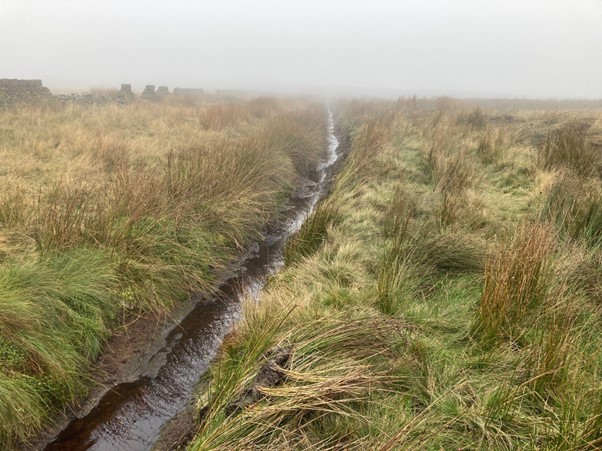
And then along the edge, past the boundary stones and on a clear day one could look south over Wadsworth Moor, part of the proposed Saudi/Bannister industrial estate. At present it serves its ecological purpose: a special green space, with special characteristics highlighted in the March 2023 Calderdale Local Plan. No wind turbines even to be considered on this land until 2032/33 it says.
We couldn’t see south, but I showed Mary and John a map of the location of each of the potential turbines. Perhaps it’s as well that there was no visibility. An estate with a current proposal for 65 turbines, and an array of solar panels glittering in the fog.
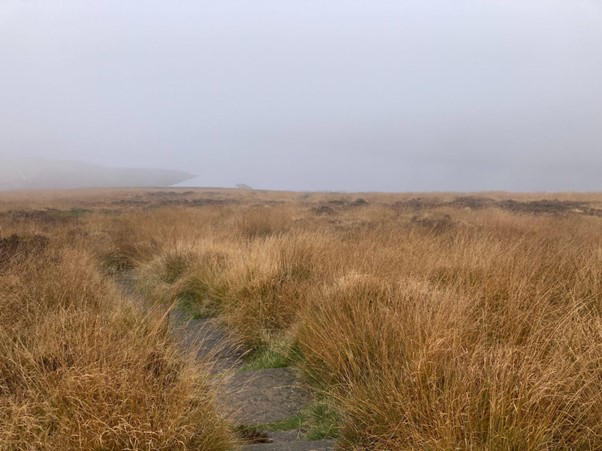
We walked the Pennine Way down to the Middle Walshaw Dean Reservoir on the stone slab pathway. Reservoirs built at the start of the 20th century to serve the industrial needs of Halifax; built on what was then the Savile Estate, necessitating the displacement of several dozen families from within the whole catchment area. We talked of socio-economic costs and benefits; winners and losers; the same discussion that present day decision makers will have to have.
But another tangent to the discussion took place by happenchance. We met one of the local gamekeepers and spent a fair amount of time talking to him. In the back of his Polaris off-road truck was a dead stoat, recently caught in a trap. This one was to be stuffed and exhibited. He talked of the ground nesting birds (lapwings, golden plovers, curlews) on the estate that he was also hoping to preserve by controlling those animals, such as the stoat, which thrived on the birds’ eggs and chicks. An interesting perspective and paradox as his boss tries to create an environment where the bird population will be severely affected, if not eradicated.
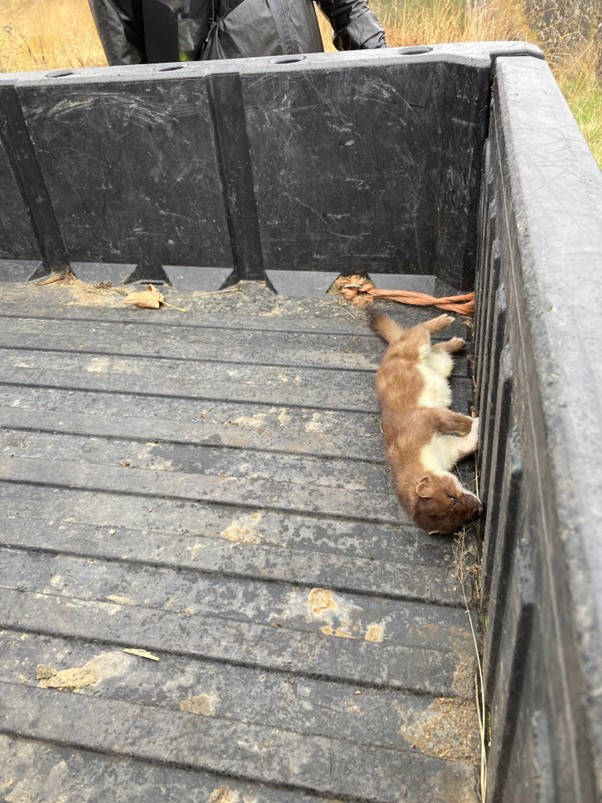
We pottered on up the hill (lunch outside the grouse shooters’ cabin at the stone benches and tables) on the Dean Gate track, which has been upgraded in contravention of the agreement with Natural England. T38 to the west of the track, T30 to the east.
We were aiming for T27 on High Rakes as our starting point for a kilometre or so of off-piste trogging.
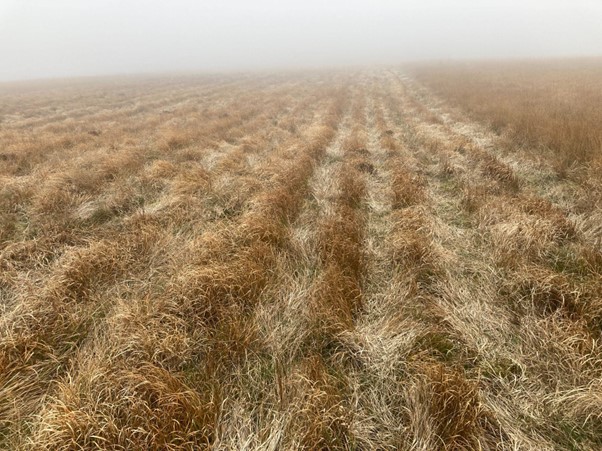
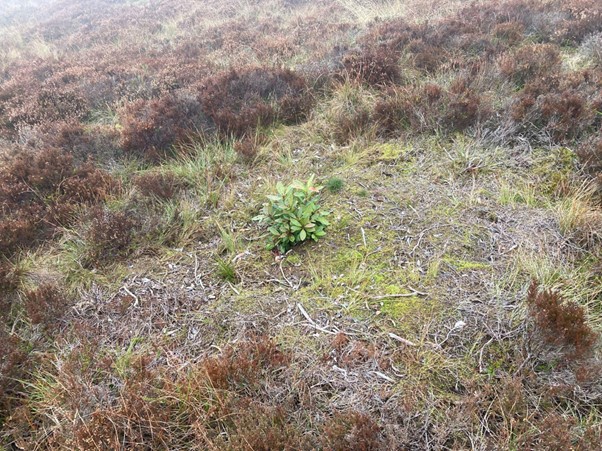
Of the given turbine sites T31 would sit on some of the deepest blanket peat. Our job was to measure the depth of peat at several locations on White Hill.
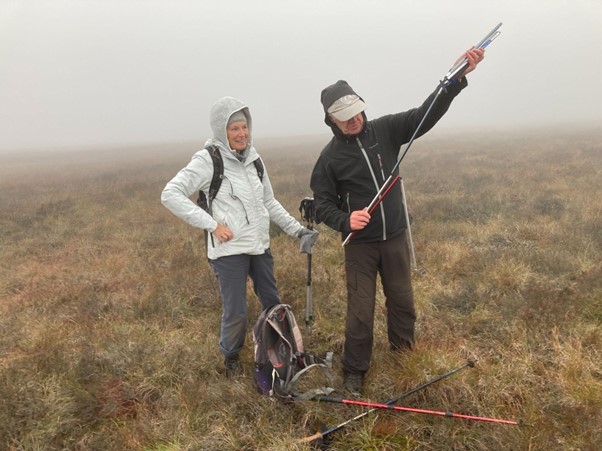
Thick mist, compass out; but instead of counting my paces as Langmuir’s Mountain Leadership Manual taught me nearly 60 years ago the tracker on my mapy.cz app (cheat, I hear them say!!) shows me the exact spot of T31. So, since we know that we’re in the right place, it’s out with the clandestine technology…….a very long articulated probe used for finding bodies in avalanched snow.
Nick had told me that he’s only used it so far on the Bronte skyline with peat 150 cm depth, and he’s hoping we’ll get it almost all the way in at White Hill. The challenge was on! We….and I mean all three of us…..pushed the probe into the peat, and pushed and kept pushing and quickly got to 150 cm , and then to 200 cm and, finally, the probe came to boulder clay at just over 240 cm deep. As John said: “The height of a goal post…or from ceiling to floor in a modern house”. And 50 m away we did it again and got the same result. So that’s a lot of carbon stored in a carbon sink, ready to be released into the atmosphere if the twenty-odd miles of roads and 65 200-metre-tall turbines are constructed.

Excellent. A job well done; but the ramifications from seeing a probe go into 240 cm of blanket peat in real life, as opposed to just reading a figure on a computer screen, are frightening.
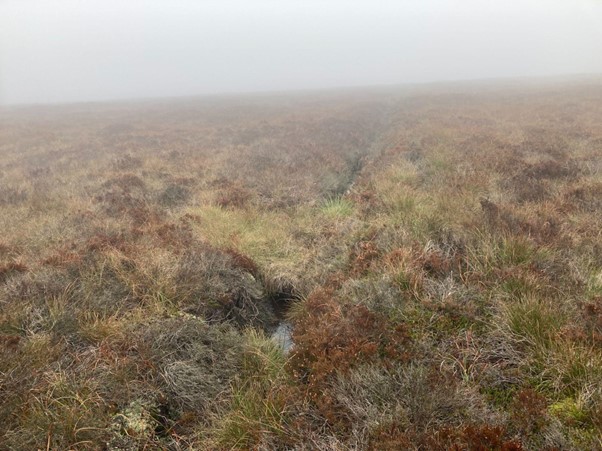
All that was left now for us to do was to take a SSE compass bearing across Black Nursery, towards T32 on the big new track (recently built to accommodate heavier vehicles …)_ then follow that out for a good mile or so to the Haworth Old Road, turn left, up and over The Top of Stairs, down to our original route along the catch, retrace our steps back to the cars, drive the cars down the road for half a mile to the Waggon and Horses pub…….bugger, it’s closed between 3 and 5! But, with a bit of non-threatening knocking on the front door, and a few gentle words of persuasion, the good landlord opened up 40 minutes early for us bedraggled old codgers (combined age of 227 years), so that he could pull us a couple of frothing pints of Titus, and make a very large cup of coffee for Mary.
14 kms walked; objective of peat depth measurement at T31 achieved. A further interesting insight into gamekeeping.
Job’s a good’un.
++++++++++++++++++++++++++++++++++++++++++++
This is the 23rd in a series of 65 guest blogs on each of the wind turbines which Richard Bannister plans to have erected on Walshaw Moor. Turbines 5, 6, 8, 9, 11, 17, 25, 27, 32, 33, 34, 35, 40, 43, 44, 47, 54, 56, 58, 62, 64 and 65 have already been described. To see all the blogs – click here.
[registration_form]